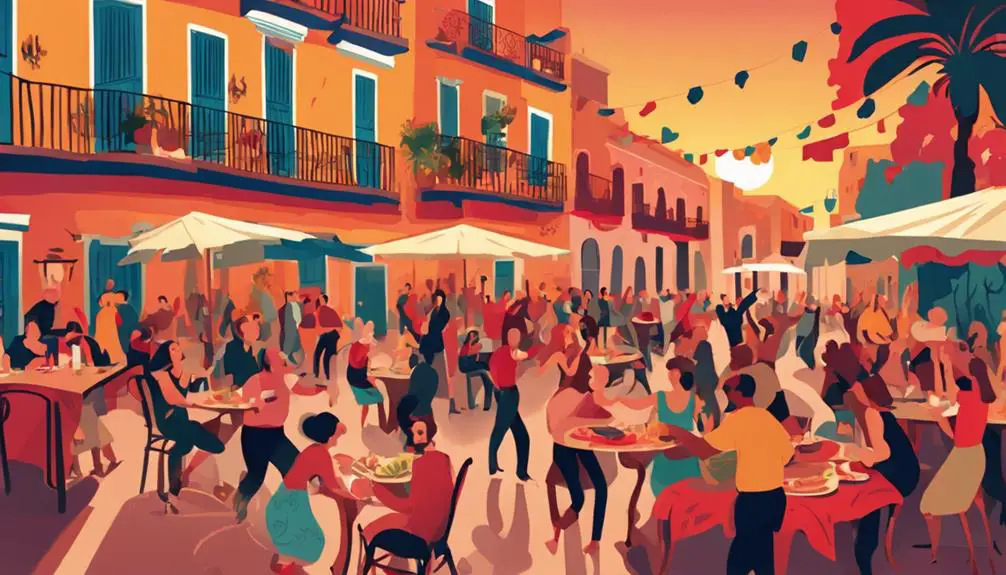When you're engaged in Spanish-speaking cultures, you'll want to master the art of slang to connect with locals and avoid cultural faux pas. From maneuvering airport lingo to understanding regional dialects, learning Spanish slang is essential for authentic experiences. You'll discover unique variations of slang in Latin America, distinct characteristics of European Spanish expressions, and essential phrases for everyday conversations. Knowing slang will help you build relationships, handle social situations, and even understand playful teasing and insults. As you explore the nuances of Spanish slang, you'll uncover more about the culture, history, and people – and discover the secrets to truly immersive experiences.
Slang Essentials for Travelers

When exploring unfamiliar streets and interacting with locals, you frequently find yourself in situations where a basic understanding of Spanish slang can make all the difference.
Airport lingo, for instance, can help you navigate through security checks and baggage claims with ease. Knowing basic phrases like '¿Dónde está…?' (where is…) or '¿Cuánto cuesta?' (how much does it cost?) can save you from frustration and confusion.
Additionally, understanding colloquial expressions can facilitate cultural immersion, allowing you to connect with locals on a deeper level. For example, using the phrase '¿Qué onda?' (what's up?) can help break the ice and establish a rapport with the people you meet.
Mastering Latin American Lingo
You'll need to explore the diverse linguistic nuances of Latin America, where regional variations of Spanish slang can greatly differ from those in Spain.
As you dive into the complex tapestry of Latin Americanisms, you'll discover that each country has its unique flavor of Spanish, shaped by cultural nuances and historical influences.
For instance, in Argentina, you'll hear 'che' used as a filler word, similar to 'um' or 'like' in English.
In Mexico, ' Güey' is a popular slang term for 'dude' or 'guy.'
Meanwhile, in Colombia, 'parce' is used to address a friend.
Mastering these regional differences will help you better connect with locals and avoid misunderstandings.
To truly immerse yourself in the Latin American experience, understanding the cultural nuances behind each expression is crucial.
By doing so, you'll be able to navigate everyday conversations with confidence and authenticity.
European Spanish Expressions

As you shift your focus from the diverse regionalisms of Latin America, you'll find that European Spanish expressions, particularly those used in Spain, exhibit a distinct character shaped by the country's history, cultural heritage, and geographical location.
The Iberian Peninsula's unique blend of Moorish, Gothic, and Mediterranean influences has given rise to a rich tapestry of regional dialects and colloquialisms.
In central Spain, Castilian colloquialisms dominate everyday conversation, with phrases like '¿Qué pasa?' (what's up?) and '¿Cómo te va?' (how's it going?) being staples of informal communication.
In the south, Andalusian idioms add a touch of flair to conversations, with expressions like 'hacerse el sueco' (to play dumb) and 'estar la mar de…' (to be extremely…).
As you delve deeper into European Spanish expressions, you'll discover a complex web of regional nuances and cultural references that will enrich your understanding of the language.
Slang for Social Situations
In social situations, mastering colloquial expressions like ¿Qué onda? (what's up?) and Estoy hasta la madre (I'm fed up) can help you maneuver everyday conversations with native speakers.
When attending social gatherings, understanding party etiquette is essential. You'll want to know phrases like ¿Quieres otra cerveza? (Do you want another beer?) or ¿Quieres bailar? (Do you want to dance?). Paying attention to social cues, such as using phrases like ¡Hagámoslo! (Let's do it!) to show enthusiasm, can also help you fit in.
Friendly banter, like using phrases like ¡Eres un crack! (You're amazing!), can help you build relationships. Understanding group dynamics and using conversation starters like ¿De dónde eres? (Where are you from?) can help you connect with others.
Being aware of social norms and cultural differences can also help you avoid unintentionally offending someone. By incorporating relational phrases like ¿Cómo te va? (How's it going?) into your conversations, you'll be well on your way to navigating social situations like a native speaker.
Insults and Teasing in Spanish

Mastering the nuances of Spanish slang also involves understanding the art of playful teasing and insults, which can be a delicate matter in social interactions, especially when managing cultural differences. You'll notice that in Spain and Latin America, friends often engage in playful jabs, which can be misinterpreted as aggression by outsiders. However, these lighthearted insults are an integral part of the social fabric, showcasing wit and sarcasm.
| Insult | Meaning | Tone |
|---|---|---|
| ¡Eres un crack! | You're an expert! | Playful, sarcastic |
| ¡Estás más perdido que un turista en Madrid! | You're more lost than a tourist in Madrid! | Teasing, humorous |
| ¡Eres un chorizo! | You're a fool! | Lighthearted, joking |
| ¡Hablas como un libro abierto! | You speak like an open book! | Sarcastic, playful |
| ¡Eres un campeón del mundo! | You're a world champion! | Ironic, humorous |
As a Sarcasm master, you'll need to navigate these nuances to avoid misunderstandings. Remember, context is key, and understanding the tone and intent behind these insults will help you build stronger relationships and avoid unintended conflicts.
Common Slang Phrases to Know
You'll frequently encounter colloquial expressions like '¿Qué onda?' (What's up?) and '¡Hagámoslo!' (Let's do it!), which are essential to understanding everyday conversations in Spanish-speaking countries.
These phrases are deeply rooted in street talk and are often explored by the youth culture to add a touch of informality to their interactions.
As you explore further into the world of Spanish slang, you'll discover that many phrases are used to convey emotions, attitudes, or even sarcastic tones.
For instance, '¡Estoy hasta la madre!' (I'm fed up!) is a common expression used to express frustration or exhaustion.
Similarly, '¡Eso es una vaina!' (That's a thing!) is used to acknowledge something as true or relatable.
Mastering these phrases will help you navigate everyday conversations with ease and confidence.
Using Slang in Everyday Life

As you incorporate colloquial expressions into your daily conversations, you'll find that using slang in everyday life can greatly enhance your relationships with native speakers and grant you a more authentic experience of the culture.
By embracing slang, you'll be able to connect with locals on a deeper level, fostering a sense of belonging and understanding. This, in turn, can lead to a stronger sense of Slang Identity, where you're able to navigate everyday situations with confidence and authenticity.
Using slang in everyday life also allows you to tap into the dynamic nature of Language Evolution. As languages adapt to changing social and cultural contexts, slang plays a significant role in shaping the way people communicate.
By staying attuned to the nuances of colloquial language, you'll be better equipped to navigate the complexities of cultural exchange. Embracing slang into your daily conversations will enable you to communicate more effectively, conveying subtle shades of meaning and nuance that might otherwise be lost in translation.
Regional Slang and Dialects
When exploring the diverse linguistic landscape of Spanish, it's important to acknowledge that regional slang and dialects not only mirror local cultural identities but also greatly impact the way native speakers communicate.
As you explore further, you'll discover that each region in the Spanish-speaking world has its unique flavor of slang and dialects. For instance, the Andean dialects spoken in countries like Peru and Bolivia are characterized by the influence of indigenous languages, resulting in distinct vocabulary and pronunciation.
On the other hand, Coastal colloquialisms in countries like Chile and Ecuador reflect the cultural exchange with African and European settlers. You'll notice that these regional dialects often blend with standard Spanish, creating a rich tapestry of linguistic diversity.
Slang for Foodies and Drinkers

While exploring regional slang and dialects, you're likely to stumble upon colloquialisms that reveal the culinary identity of a region, particularly in the domain of food and drink. In Spain, food is an integral part of the culture, and the language reflects this.
For instance, the concept of 'Tapas Talk' is a staple of Spanish social life, where small plates of food are shared among friends and family. You might hear someone say '¿Quieres tapear?' (Want to go tapas-hopping?) or 'Vamos a tapear' (Let's go tapas-hopping!).
When it comes to drinks, the 'Brew Buzz' is all about the art of coffee-making. In Spain, coffee is an integral part of daily life, and locals have developed a unique coffee culture. You might hear someone say 'Tomar un café' (Let's grab a coffee) or 'Vamos a tomar un café' (Let's go get a coffee).
In the evenings, the focus shifts to 'La hora del vermú' (Happy Hour), where friends gather to enjoy a drink and some tapas. By embracing these colloquialisms, you'll be well on your way to becoming a true Spanish foodie and drink connoisseur.
Frequently Asked Questions
Is Spanish Slang Different in Different Countries?
As you explore the nuances of Spanish, you'll discover that yes, Spanish slang indeed varies across different countries. Regional dialects and country-specific expressions shape the language, making it distinct in each region.
You'll notice that idioms, vocabulary, and pronunciation differ between, say, Spain and Latin American countries, or even within regions like Mexico or Argentina.
Can I Use Slang in Formal Writing or Emails?
When writing formal emails, you should maintain a professional tone, avoiding slang and colloquialisms. You're aiming for clarity and respect, not casual familiarity.
In professional communication, prioritizing precision and formality is crucial. Avoid using slang, even if it's commonly used in informal settings. Instead, opt for standard language that conveys your message effectively. This will help you establish credibility and maintain email etiquette.
Are There Any Slang Words That Are Specific to Women?
You're wondering if there are slang words exclusive to women? Well, let's get real, you're not going to find a 'Girls Only' section in the dictionary.
But, in reality, mujeres hablar (women speak) and chicas (girls) do have their own vocabulario (vocabulary).
While not exclusively female, some slang terms like 'chulería' (a playful, flirtatious attitude) or 'piba' (a young, stylish woman) are more commonly used among women.
Can I Create My Own Slang Words in Spanish?
You're wondering if you can create your own slang words in Spanish. The answer is yes!
You can craft your own slang by experimenting with Word Fusion, blending words to create novel expressions. This Slang Craft requires creativity and an understanding of Spanish linguistic patterns.
By combining familiar words in innovative ways, you can coin fresh slang terms that resonate with native speakers.
Are There Any Slang Words That Are Offensive to Certain Groups?
When exploring informal language, you should be aware that certain slang words can be offensive to specific groups. Cultural insensitivity and perpetuation of harmful stereotypes can be embedded in these terms.
You must recognize that using such language can contribute to the marginalization of already vulnerable communities. Be cautious not to perpetuate harmful slang stereotypes, and instead, opt for respectful and inclusive language that promotes understanding and empathy.
Conclusion
As you navigate the vibrant streets of Spain or the colorful markets of Latin America, you've got the slang essentials to blend in seamlessly. From mastering Latin American lingo to tossing around European Spanish expressions, you've learned to navigate social situations with ease.
Yet, amidst the fiesta, remember that slang can be a double-edged sword – wield it with care, lest you unintentionally offend. By embracing regional dialects and avoiding faux pas, you'll savor the flavors of Spanish culture like a local.







